Czech small arms in service with Nazi Germany
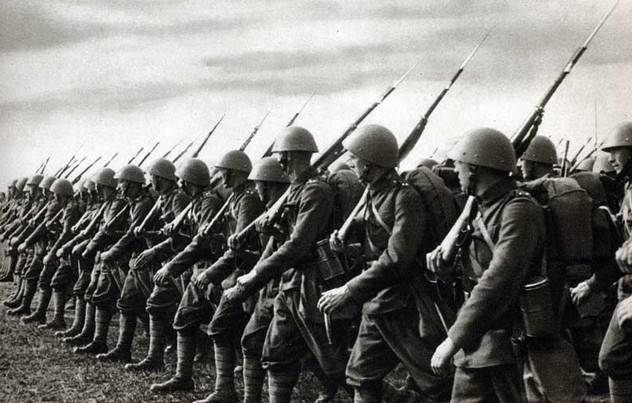
In 1938, with the connivance of Great Britain and France, Nazi Germany annexed Czechoslovakia. Although this country had a developed defense industry, and the size of the armed forces numbered about 1,3 million people, there were 26 well-equipped infantry divisions and 12 border areas, in terms of numbers equivalent to infantry divisions and designed to defend long-term fortifications, the Czechoslovak army almost did not resist invaders. As a result of the Munich Agreement, signed on September 30, 1938, Germany annexed the Sudetenland, and in mid-March 1939, the Czechoslovak leadership agreed to the dismemberment and occupation of the country. On the territory occupied by the Germans, the Reich Protectorate of Bohemia and Moravia was created. At the same time, Slovakia received formal independence under the patronage of Berlin.
If it were not for the betrayal of Western politicians who were trying to "appease the aggressor", the Czechoslovak army could have put up serious resistance to the Wehrmacht. So, according to archival data, the Germans without a fight got 950 combat aircraft, 70 armored trains, armored cars and railway artillery batteries, 2 field guns, 270 mortars, 785 tanks, tankettes and armored vehicles, 43 machine guns, more than 876 million rifles. More than 1 billion rounds of ammunition and more than 1 million shells were also captured. The air defense of Germany and its allies was strengthened by those captured in Czechoslovakia: 3 medium-caliber anti-aircraft guns, 230 small-caliber anti-aircraft guns and 227 anti-aircraft machine-gun installations.
The Germans got stocks of weapons, which made it possible to equip 9 infantry divisions, a number of police and auxiliary formations. By the time of the attack on Poland by Czech infantry weapons and artillery was equipped with five German infantry divisions, as well as many smaller units and subunits. The Slovak corps, which consisted of a motorized brigade and two infantry divisions, participated in the Polish campaign on the side of Germany, was also equipped with Czech equipment and weapons inherited from Czechoslovakia.
In total, Slovakia, when dividing the property of the Czechoslovak army, received 713 field guns, 24 anti-aircraft guns, 21 armored vehicles, 30 tankettes, 79 tanks and 350 aircraft. By the end of 1940, four more infantry divisions were equipped with Czech weapons, and by the time the Great Patriotic War began, a significant proportion of the weapons available in the German armed forces and in the armies of the German satellite countries had been fired by the Czechs. Until the surrender of Germany, the Nazis actively used the defense industry of Bohemia and Moravia. The production of small arms, artillery systems, armored vehicles and fighter aircraft under German orders in the Czech Republic continued until May 1945.
Enterprises involved in the production of small arms in Czechoslovakia
After the end of the First World War, the Austro-Hungarian Empire ceased to exist, and on October 28, 1918, power in Prague passed to the Czechoslovak National Committee. Almost immediately after the formation of independent Czechoslovakia, territorial disputes with neighbors began, accompanied by armed clashes at the borders. The new national government of Czechoslovakia was forced to strengthen the army and equip it with modern weapons. To this end, in addition to expanding and modernizing existing defense enterprises, new arms factories were being built.
So, in 1919, the Jihočeská zbrojovka factory, now known as Česká zbrojovka Strakonice (CZ), was built in the city of Strakonice. Until 1946, the company produced small arms, but then the weapons branch was separated into the company Česká zbrojovka Uherský Brod with production in the city of Uherský Brod. The oldest enterprise in the Czech defense industry was Zbrojovka Brno, which until 1918 was a branch of the Vienna Artillery Arsenal.
Pistols
The first pistol produced in Czechoslovakia and officially adopted by the army and police was the ČZ vz. 22, also known as Pistole N.
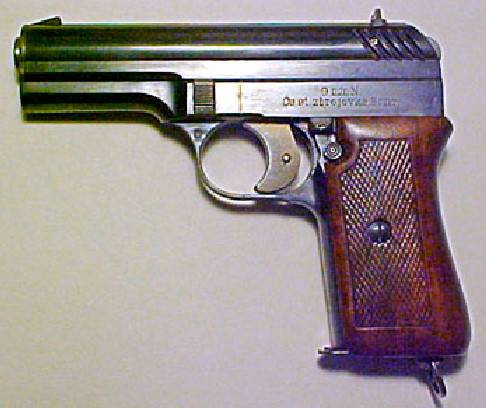
Pistol ČZ vz. 22
The mass of the pistol without cartridges is 640 g. The length of the weapon is 155 mm. Height - 142 mm. Barrel length - 89 mm. The effective firing range is up to 30 m. Automation works due to the short stroke of the barrel. Locking is carried out by turning it with the help of lugs located in the rear of the barrel, which is unusual for weapons fired from a relatively weak cartridge. The trigger mechanism is of the trigger type, single action, with a preliminary cocking of a semi-hidden trigger. Magazine for 8 rounds.
Pistol ČZ vz. 22 was created by designer Josef Nickl on the basis of his 1915 model of the year chambered for Nickl 9 mm. This ammunition was actually a version of the .380 ACP cartridge, but had slightly weaker ballistic characteristics.
In general, the admissions committee liked the gun, but experts demanded that it use standard 9 × 17 mm cartridges, and it was also necessary to refine the design of the barrel, reflector, sight, striker and trigger. In addition, the military was not quite satisfied with the shutter lock mechanism. After the last cartridge was used, the bolt remained in the open position until a full magazine was inserted. Representatives of the defense department wanted the bolt lock to be removed already when an empty magazine was removed.
Production of pistols ČZ vz. 22 continued until 1924. More than 20 thousand pistols were produced, which were used by the Czechoslovak military and police.
The main disadvantage of this pistol is the discrepancy between the power of the cartridge used and the complexity of the design, since such an automation scheme is usually used in weapons designed for the more powerful 9 × 19 Para cartridge.
Further development of the ČZ vz. 22 became ČZ vz. 24 chambered in .380 ACP. The new model was more streamlined and easier to use. Pistol ČZ vz. 24 looks a little more massive and feels more comfortable in the hand.
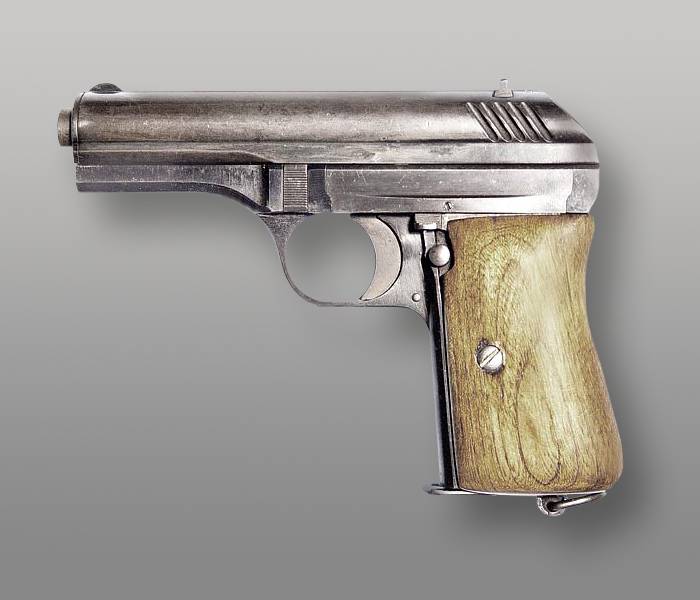
Pistol ČZ vz. 24 early series
Weight without cartridges - 680 g. Length - 160 mm. Barrel length - 90 mm. Magazine capacity is 8 rounds. Muzzle velocity: 295–300 m/s.
The military noted reliability, durability, ease of use. High quality materials used in production and high quality workmanship were emphasized. Until 1938, more than 100 thousand ČZ vz pistols were produced. 24.
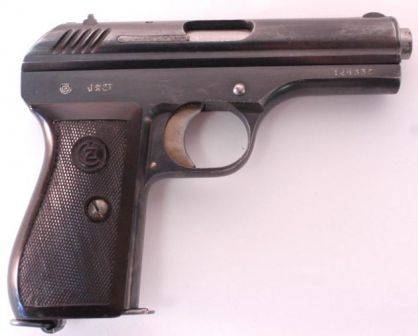
Pistols ČZ vz. 24s produced in the late 1930s had improved exterior finishes.
For export deliveries in 1927, the ČZ vz pistol was created. 27, which used the .32 ACP cartridge (7,65x17mm). Unlike previous models, its automation worked on the principle of a free shutter, which made it possible to make the weapon simpler, cheaper and more reliable.
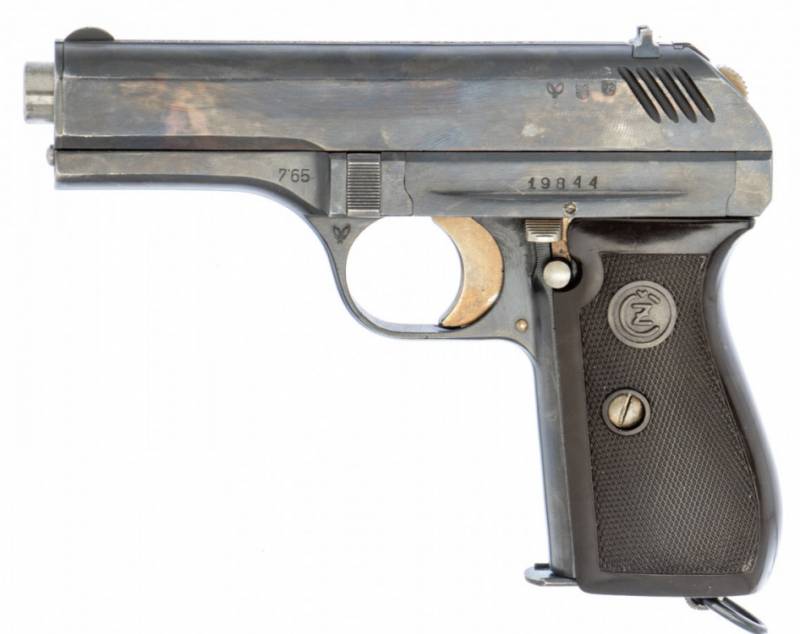
Pistol ČZ vz. 27
The mass of an unloaded pistol is 670 g. Length - 155 mm. Height - 125 mm. Barrel length - 99 mm. Magazine for 8 rounds.
The calculation of the designers and management of the Strakonice branch of the Prague arms factory Ceska Zbrojovka turned out to be correct. The new 7,65mm pistol sold better than previous 9mm models. Few of them entered the Czechoslovak army; inside the country, the customers were mainly the internal security structures, the treasury and the police. At the same time, the ČZ vz. 27 was not bad for personal self-defense of individuals.
According to reference data, at least 620 7,65 mm ČZ vz pistols were produced. 27, of which more than 400 thousand during the German occupation. For use for training purposes, pistols chambered in 5,6 mm caliber were produced. There was also a version with a silencer, with an elongated barrel and a thickened muzzle.
After Germany annexed the Czech Republic, ČZ vz. 22, ČZ vz. 24 and ČZ vz. 27 was used by the armed forces and police of Germany and Slovakia under the designation Pistole 22(t), Pistole 24(t) and Pistole 27(t). Since Czech pistols were seriously inferior in power to the German Walther P38 and Luger P08 chambered for 9 × 19 Para, they were mainly armed with units that were not directly involved in hostilities: police, security and auxiliary units, as well as senior officers.
Submachine guns
In the mid-1930s, the designers brothers Frantisek and Josef Koutski, who worked at the Zbrojovka Brno enterprise, developed the ZK-383 submachine gun.
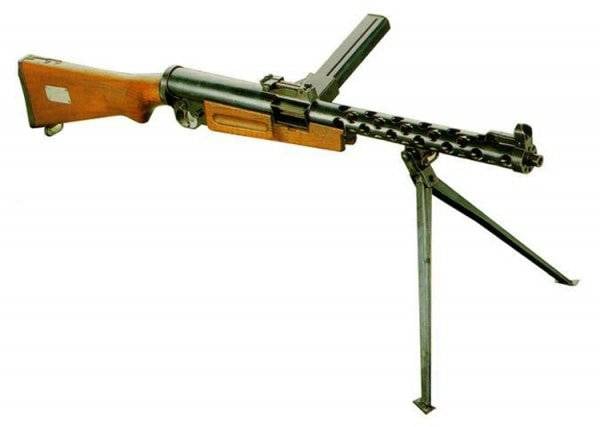
Submachine gun ZK-383 with bipod
Initially, this weapon chambered for 9 × 19 Para was designed as a means of fire support for an infantry unit at short combat distances and was considered as an "ultralight machine gun" chambered for a pistol cartridge. The concept of use affected the features of this sample. It has relatively large dimensions and weight, a quick-change barrel, like on machine guns, the location of the magazine on the left, the presence of bipods and the ability to adjust the rate of fire.
Like most submachine guns designed in the 1930s, the ZK-383 uses blowback automatics, firing from the rear sear. The barrel with a massive perforated casing that protects the shooter from burns is quick-change, the barrel lock is located at the base of the front sight on the barrel casing. On the casing of the barrel there is a mount for a folding bipod, which in the stowed position is partially retracted into a groove on the forearm.
The trigger mechanism provides single and automatic fire. By adjusting the mass of the shutter with the help of a replaceable weight of 17 g, you can change the rate of fire from 500 to 700 rds / min. A low rate is used when firing from the hands, a high rate is used when firing from bipods in machine gun mode. The ZK-383 had a front sight and a frame sight marked up to 600 meters. But the effective firing range from bipods did not exceed 250 m.
Without cartridges, the ZK-383 weighed 4,25 kg. The length of the weapon is 899 mm. Barrel length - 325 mm. The initial speed of the bullet is 380 m / s. Magazine capacity - 30 or 40 rounds.
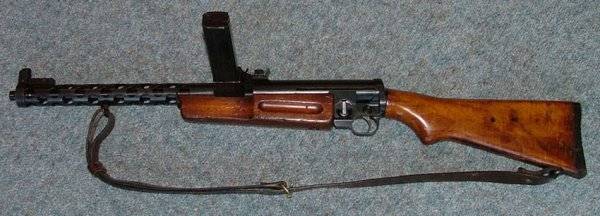
Submachine gun ZK-383P
In addition to the infantry "ultralight machine gun", a lightweight ZK-383P police submachine gun without a bipod was produced.
Taking into account the copies exported and released in the post-war period, a total of about 20 thousand ZK-383 of all modifications were produced. There were few such submachine guns in the Czechoslovak army, and it was not possible to equip each infantry squad with these weapons by March 1939. Due to the high quality of workmanship, the weapon enjoyed some success with foreign buyers and was supplied to Bulgaria, Venezuela and Ecuador. The production of ZK-383 submachine guns continued during World War II and ended in 1947.
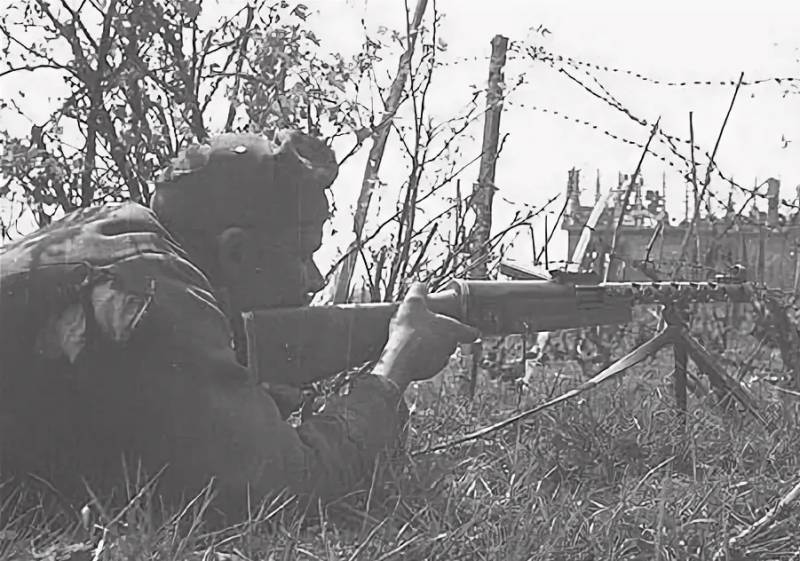
Bulgarian soldier firing a ZK-383 submachine gun
Submachine guns ZK-383 entered service with Waffen-SS units and individual police units, a certain number of ZK-383Р were in service with the police of Bohemia and Moravia.
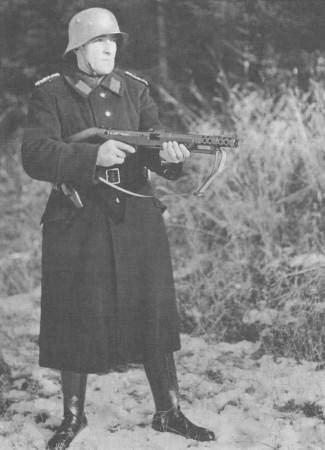
In 1942, the ZH-403 submachine gun (Waffenwerke Brunn MP.42) with a lower vertical magazine was presented for testing. The sample passed factory tests, however, due to the lack of advantages over mass-produced German samples, it was not transferred to production.
Rifles
After the declaration of independence of Czechoslovakia, the main weapon of the infantryman until the end of the 1920s remained the Austrian rifle Mannlicher M1895 chambered for 8 × 50 mm R, adopted under the designation vz. 1895. During the division of the military property of the Austro-Hungarian Empire, the Czechoslovak army got about 200 thousand rifles.

Rifle Mannlicher M1895
An interesting feature of this rifle is the "direct action" bolt, with a straight stroke without turning. The rotation of the shutter larva for locking was carried out automatically due to special spiral grooves on its stem. This increased the rate of fire and ease of use of the weapon, but complicated its design, reduced reliability and increased the effort applied by the shooter when reloading.
With a total length of 1 mm, without the Mannlicher bayonet of the 272 model, it weighed 1895 kg. A bullet weighing 3,78 g was accelerated in a barrel 15,9 mm long to 765 m/s. The rifle is fed with ammunition from an integral box-shaped single-row magazine with a capacity of five rounds. The magazine is loaded using a pack-type clip, pre-loaded with cartridges, which is inserted into the magazine from above. When all the cartridges are used up, an empty pack falls out through a special window under the action of its own weight.
The rifle was superior in rate of fire to other samples with a sliding bolt with a turn. A well-trained shooter could fire 20 aimed shots per minute.
Already in 1919, the Zbrojovka Brno factory began production of first spare parts, and then rifles mod. 1895, which lasted until June 1922. However, cartridges were produced for another 12 years.
Subsequently, in connection with the transition to the 7,92 mm rifle Vz. 24, all M1895s were withdrawn from combat units and sent to warehouses. Some of the Mannlichers were converted to the 7,92 × 57 mm cartridge (7,92 × 57 Mauser), they were planned to be sold on the foreign market. Bulgaria bought a large batch of rifles.
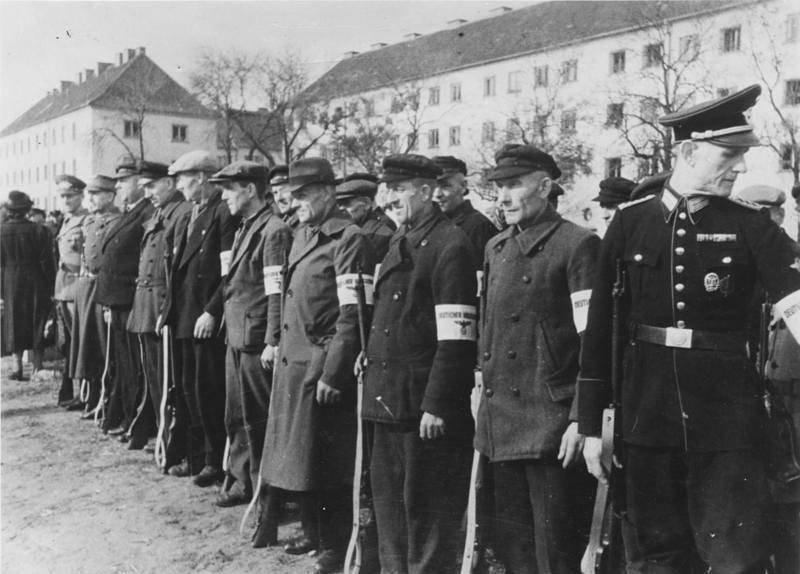
Volkssturm fighters
In 1938, the Mannlichers that were in storage were captured by the Wehrmacht. Approximately half of the captured M1895 rifles were handed over to the allies by the Germans, they were armed with auxiliary units, as well as teenagers and old people drafted into the Volkssturm at the final stage of the war.
In the early 1930s, the Vz. 24, which is a licensed version of the German rifle Gewehr 1898 (Mauser 98).

Rifle Vz. 24
The production of their own version of the Gewehr 1898 rifle with a longitudinally sliding rotary bolt at the enterprise in Brno has been trying to establish since 1919. Things got off the ground after Waffenfabrik Mauser AG supplied Czechoslovakia with a large number of metalworking machines, as well as technological documentation.
The first version of the Czechoslovak Mauser was designated M1898/22. These were German rifles restored in Czechoslovakia, produced before and during the First World War. In addition, the Germans handed over components, from which the Czechs managed to assemble 42 thousand rifles, which received the designation Vz. 23. Model known as Vz. 24 was assembled from parts made in Czechoslovakia.
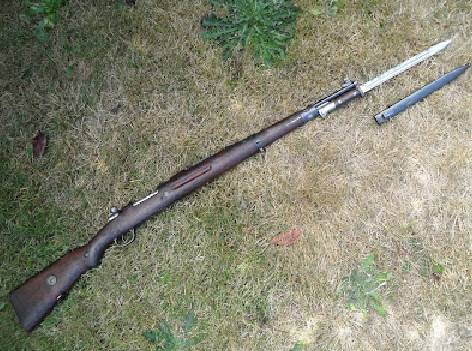
Rifle Vz. 24 with a bayonet
Compared to the original sample, which had a 740 mm barrel, the Czech designers shortened the barrel length to 590 mm. The total length without a bayonet is 1 mm. Weight - 100 kg. Magazine capacity - 4,08 rounds. Loading was carried out with a clip or one cartridge. Combat rate of fire - 5 rds / min. The muzzle velocity of the 12-g bullet was 12,8 m/s. The sights were designed for a distance of 760 m, but with a mechanical sight, the effective firing range did not exceed 2 m.
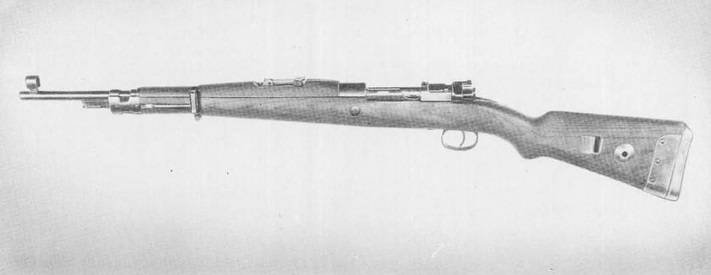
Carbine Vz 12/33
A sniper rifle was also produced, with a bracket for optics and a bolt handle bent down. In addition, shorter versions were produced in Czechoslovakia, known as Vz 12/33 and VZ 16/33. The carbines featured a 490 mm barrel, a curved bolt handle, and a new bayonet.
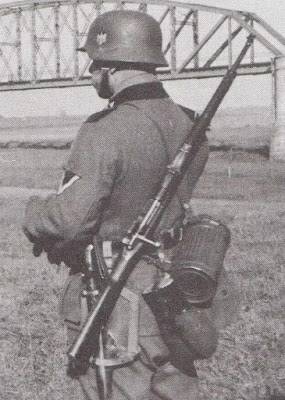
After the occupation of Czechoslovakia by Germany, the Vz. 24 was adopted by the Wehrmacht under the name Gewehr 24 (t). Police carbine Vz 16/33 received the name Gewehr 33/40 (t). The volume of production of carbines was significant, by the beginning of 1943 the Czechs had delivered more than 250 thousand Gewehr 33/40 (t). From Germany's allies, Czech rifles and carbines were also supplied to Romania. Due to their relatively small size, carbines were popular in mountain rifle, airborne and sapper units - wherever a compact, reliable and high-quality weapon was required.
The production of rifles and carbines by Czech factories continued until the end of 1944. Although the exterior finish of the weapon had deteriorated significantly compared to the pre-war level, the workmanship was still good.
In the prewar years, Czechoslovakia was one of the few countries where self-loading rifles were being created. In the 1920s and 1930s, several samples were designed and embodied in metal, but Emanuel Kholek achieved the greatest success with the ZH-29 rifle chambered for 7,92 × 57 mm.

Self-loading rifle ZH-29
An interesting fact is that the ZH-29 rifle, produced until 1939, was designed and manufactured by order of China, which urgently needed rapid-fire small arms to fight the Japanese invaders. Small batches of ZH-29 self-loading rifles were purchased by Greece, Romania, Lithuania, Turkey and Ethiopia. In the 1930s, improved export versions of the ZH-32 and ZH-36 appeared, differing from the original model in details.
The army of Czechoslovakia tested self-loading rifles, but there was no order for them. The generals felt that the already existing magazine rifles were quite enough for the infantrymen, and the higher cost and complexity of operating semi-automatic weapons did not justify the increase in the firepower of infantry units.
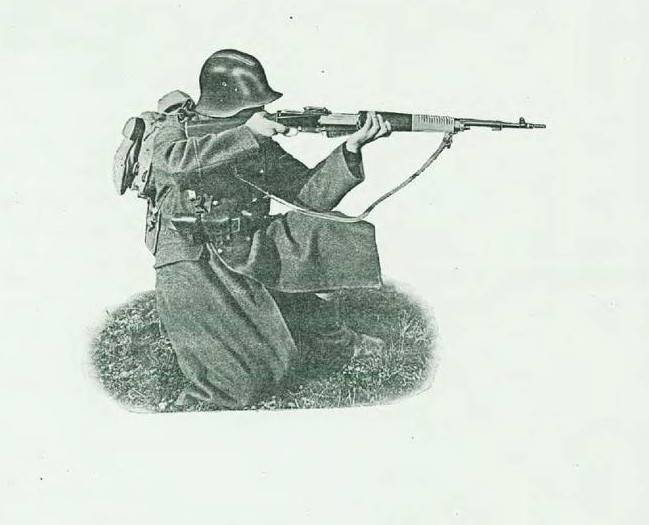
Compared to the standard manually reloaded Vz. 24 self-loading ZH-29 was slightly heavier. Its weight without cartridges was 4,5 kg. Length - 1 150 mm. Barrel length - 545 mm. Removable magazines for 5 and 10 rounds could be used. A number of sources say that magazines from a ZB vz light machine gun came up to the rifle. 26. Combat rate of fire - up to 25 rounds per minute.
Automation ZH-29 worked by removing part of the powder gases through a transverse hole in the barrel wall. The locking of the barrel was achieved by tilting the bolt to the left, a cutout in the wall of the receiver. To adjust the amount of exhaust gases depending on the firing conditions in the gas chamber, there was a gas regulator. The exhaust system and sights had an unusual location - they are somewhat shifted to the right. The ZH-29 rifles were produced both in self-loading and automatic versions, with the ability to fire in bursts.
After establishing control over the Czech arms factories, the German administration refused to produce self-loading rifles. Nevertheless, several hundred ZH-29s, ZH-32s and ZH-36s, which were available in the warehouses of finished products, came into the possession of the occupying authorities and were subsequently used by the Waffen-SS and Slovak formations.
To be continued ...
Information